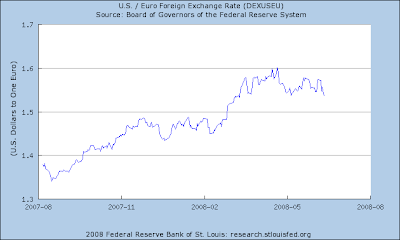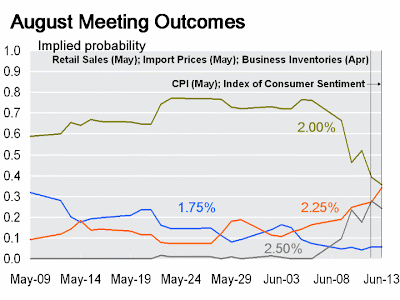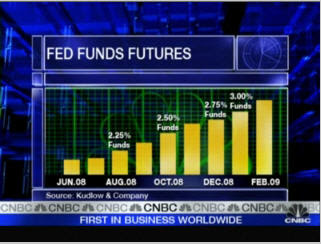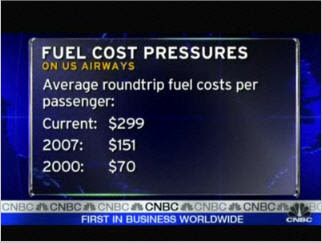Stephen Roach: New stagflation made in Asia
Stephen Roach argues on Financial Times that a new stagflation scenario is not likely to be wage-price-spiral type, but of Asian-exported.
First, world has never been so integrated in terms of trade:
The globalisation of trade flows is a new transmission mechanism of worldwide inflation that was not evident in the 1970s. According to estimates from the International Monetary Fund, overall exports should hit a record 32.5 per cent of world gross domestic product in 2008…
Second, inflation in Asia is flashing red alert:
For developing Asia as a whole, consumer price index inflation hit 7.5 per cent in April 2008, close to a 9½-year high and more than double the 3.6 per cent pace of a year ago. Sure, a good portion of the recent acceleration in pricing is a result of food and energy – critically important components of household budgets in poorer countries and yet items that many analysts mistakenly remove to get a cleaner read on underlying inflation. But even the residual, or “core”, inflation rate in developing Asia surged to 3.8 per cent in April, more than double the 1.8 per cent pace of a year ago.
China’s inflation problem is much deeper than the food and energy price shocks that thus far have played a disproportionate role in driving its consumer price index higher. Also at work are serious wage pressures reflecting, in part, increases in minimum wages associated with new labour reform laws. Meanwhile the People’s Bank of China has held its policy lending rate below headline inflation, resulting in negative real short-term interest rates.The result has been an ominous increase in Chinese inflationary expectations, strikingly reminiscent of similar occurrences that plagued the developed world in the 1970s and early 1980s. History does not treat kindly a serious deterioration in inflationary expectations. The longer such a trend persists, the more wrenching the monetary tightening required to arrest it – and the greater the risk of a subsequent hard landing. That is the last thing China wants or needs.China is hardly alone in its reluctance to take firm action against a worrying build-up of inflationary pressures. That is true throughout most of developing Asia, where hyper-growth is viewed as the panacea for the aspirations of a growing middle class. Throughout the region, central banks are keeping short-term interest rates far too low to combat these inflationary pressures. For developing Asia as a whole, a GDP-weighted average of policy rates is currently about 6.75 per cent, fully three-quarters of a percentage point below the 7.5 per cent headline inflation rate.
Alan Blinder on "Bubble and Central Banks"
Alan Blinder, Professor of economics at Princeton and former Fed Governor, contributes to the much heated debate on whether central banks should prick the bubbles.
He differentiates two types bubbles: bank-centered bubbles and bubbles not based on bank lending. Central banks have more and better information on the bank-centered bubbles and have a lot of tools to deal with it rather than raising interest rate. For the non-bank-based bubble, central banks have no information advantage and monetary policy tools rarely “fit the crime”. (source: NYT)
I would argue that the central bank’s proper role is fundamentally different in the two types of bubbles. Here’s why:
When bubbles are not based on bank lending, the Fed has no comparative advantage over other observers in distinguishing between rising fundamentals and bubbly valuations. It may see bubbles where there are none, or fail to recognize them until it’s too late — or probably both.
Indeed, at the Fed, I recall Mr. Greenspan thinking that he saw a stock market bubble as early as 1995, when Internet stocks barely existed and the Dow was under 5,000. Fortunately, he did not make the mistake of trying to burst it. Conversely, the tech bubble became obvious only in 1999 — by which time it was already enormous.
That’s the first problem, and it’s a huge one. Here’s the second:
Once a central bank correctly recognizes a bubble’s existence, what is it supposed to do? The Fed has no instruments aimed directly at, say, tech stocks, and practically no instruments aimed at stock prices more broadly. (Those who argued that higher margin requirements would have worked were engaged in deeply wishful thinking.)
Of course, the Fed could have raised interest rates. But why would raising the federal funds rate by, say, two to three percentage points have ended the stock market mania when investors were expecting 19 percent annual returns in the stock market? That much monetary tightening, however, might well have stopped the economy in its tracks. If that strikes you as a good bargain, you might enjoy reading Cotton Mather’s autobiography.
But a bank-centered bubble is starkly different in both respects.
As long as the central bank is also a bank supervisor and a regulator, it is extraordinarily well placed to observe and understand bank lending practices — much better positioned than almost anyone else. Beyond merely knowing more, part of a bank supervisor’s job is to make sure that banks don’t engage in unsafe and unsound lending, and to scowl at or discipline them if they do. We know that America’s bank regulators fell down on the job as the housing-mortgage bubble inflated. But that was a failure of bank supervision, not of monetary policy.
AND what about instruments specifically aimed at the bubble? Whereas the Fed’s kit bag is pretty much empty when it comes to stock-market prices, it is stuffed full when it comes to taking aim at bank lending practices. Escalating upward from a sternly arched eyebrow to an outright prohibition of certain types of lending — for example, subprime loans with no documentation for 100 percent of a home’s appraised value — bank supervisors have a broad range of finely calibrated weapons at their disposal. Like the Mikado, they can “let the punishment fit the crime.”





